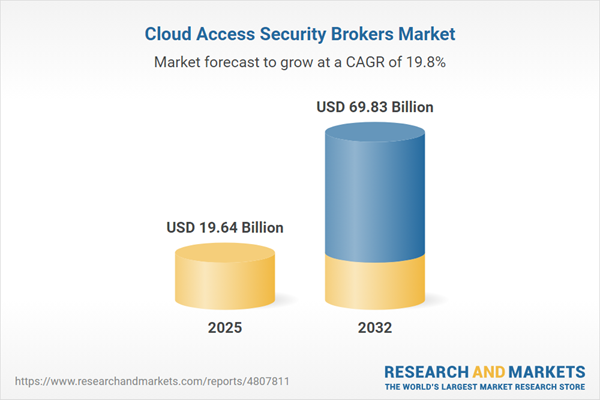Speak directly to the analyst to clarify any post sales queries you may have.
The global cloud access security broker market is gaining momentum as organizations prioritize integrated cloud security for increasingly complex and agile digital ecosystems. Senior decision-makers are leveraging CASB solutions to bridge security gaps, ensure regulatory alignment, and safeguard critical business operations throughout ongoing digital transformation.
Market Snapshot: Global Cloud Access Security Broker Market
Cloud access security broker platforms are advancing rapidly as businesses pursue greater investment in cloud-based technologies and drive broad digital initiatives. As enterprise cloud usage scales, organizations must meet expanding regulatory expectations and enforce unified security policies across environments, including public, private, and hybrid infrastructures. The rise of distributed workforces and a shift toward remote operations increase the necessity for modern security tools that offer immediate threat detection, deeper analytics, and automated controls. CASB providers are responding with centralized platforms that integrate seamlessly into existing cloud ecosystems, enabling secure data transfer and stronger operational continuity worldwide. These comprehensive security solutions are now central to ensuring agile risk management and continuous business uptime amid accelerated adoption of cloud services.
Scope & Segmentation
- Service Types: Advanced API protection minimizes exposure across cloud workloads, while robust compliance management simplifies audit and regulatory workflows. Encryption and tokenization secure sensitive data in motion, and adaptive threat prevention equips organizations to act swiftly when incidents arise.
- Deployment Models: CASB solutions offer flexibility for integration across public, private, hybrid, and on-premises environments. This ensures adaptability for current IT environments and supports smooth future cloud migrations.
- Organization Sizes: Scalable architectures enable both large enterprises and small to mid-sized businesses to meet unique risk profiles and security requirements as they progress through different growth stages.
- Industry Verticals: Industry-specific CASB features address compliance, process efficiency, and risk management in sectors such as finance, government, healthcare, IT, telecom, retail, and ecommerce.
- Regions: North America—including the United States—and countries like the United Kingdom, Germany, and Japan demonstrate established CASB frameworks due to stringent compliance obligations. In contrast, Brazil, United Arab Emirates, China, India, and South Africa represent dynamic markets adopting CASB technology to address emerging regulatory requirements and evolving security risks.
- Key Companies Covered: The market is shaped by vendors like Microsoft Corporation, Broadcom Inc., Netskope, Inc., McAfee LLC, Cisco Systems, Inc., Palo Alto Networks, Inc., Forcepoint LLC, Bitglass, Inc., Proofpoint, Inc., and CipherCloud, Inc., all delivering unified security features and integration capabilities.
Key Takeaways for Senior Leaders
- Seamlessly integrating CASB platforms with identity and access management improves oversight and bolsters security control, particularly for distributed and remote teams.
- Advanced anomaly detection tools within leading CASB offerings support fast threat identification and underpin proactive security measures for incident response.
- Centralized administration of policies streamlines compliance and governance, particularly valuable for multinational enterprises and regulated sectors.
- API-driven system designs deliver improved monitoring and visibility, accommodating dynamic and multi-cloud environments which enhances business reliability.
- Industry-tailored CASB features support evolving compliance needs while reinforcing organizational resilience against emerging and complex risks.
Tariff Impact: Adapting Cloud Security Procurement
New U.S. tariffs anticipated in 2025 are influencing both enterprise and provider procurement strategies within the cloud access security broker market. Companies are reviewing infrastructure plans to proactively address supply chain risks and maintain consistent access to security solutions. This strategic shift also supports compliance with newly developing regulatory frameworks, ensuring uninterrupted cloud security operations despite changing global trade dynamics.
Methodology & Data Sources
This report combines direct interviews with IT and security executives, assessments of contemporary industry research, ongoing analysis of regulatory trends, and perspectives from leading CASB vendors. Careful fact-checking ensures that leaders receive actionable and reliable recommendations for evaluating CASB solutions and strategies.
Why This Report Matters
- Deep segmentation and market insights guide senior executives in prioritizing strategies for effective CASB adoption supporting large-scale digital transitions.
- Comprehensive analysis of CASB trends and compliance evolutions clarifies key technical and regulatory issues facing each vertical.
- Actionable recommendations connect cloud security solution choices with compliance demands and organizational growth objectives.
Conclusion
Strategic adoption of CASB technologies fortifies security and compliance postures, allowing organizations to remain agile and ready for future digital requirements. These solutions support ongoing transformation and operational success in the evolving enterprise landscape.
Additional Product Information:
- Purchase of this report includes 1 year online access with quarterly updates.
- This report can be updated on request. Please contact our Customer Experience team using the Ask a Question widget on our website.
Table of Contents
3. Executive Summary
4. Market Overview
7. Cumulative Impact of Artificial Intelligence 2025
Companies Mentioned
The companies profiled in this Cloud Access Security Brokers market report include:- Microsoft Corporation
- Broadcom Inc.
- Netskope, Inc.
- McAfee LLC
- Cisco Systems, Inc.
- Palo Alto Networks, Inc.
- Forcepoint LLC
- Bitglass, Inc.
- Proofpoint, Inc.
- CipherCloud, Inc.
Table Information
| Report Attribute | Details |
|---|---|
| No. of Pages | 199 |
| Published | October 2025 |
| Forecast Period | 2025 - 2032 |
| Estimated Market Value ( USD | $ 19.64 Billion |
| Forecasted Market Value ( USD | $ 69.83 Billion |
| Compound Annual Growth Rate | 19.8% |
| Regions Covered | Global |
| No. of Companies Mentioned | 11 |









